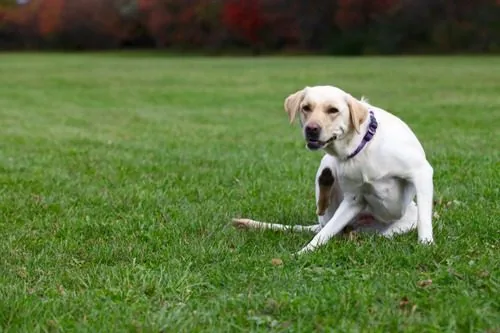Blood in Stool: What It Means for Your Dog
If you notice blood in your dog’s stool, typically it may be nothing to be worried about if it only happens occasionally, but it’s not normal and may be the result of an underlying health problem. Blood in the stool may be a sign of gastrointestinal inflammation, colitis, foreign body ingestion, or some other health issue.

If you notice blood in your dog’s stool, try to pay attention to any other symptoms or signs she may show, and be sure to contact your veterinarian if you are concerned or have questions.
What Causes Blood in Dog Stool?
There are several reasons why blood might appear in a dog’s stool, and the causes depend on the appearance of the blood, whether it is bright red, dark red, or black.
Causes of Bright Red Stools
Bright red blood, hematochezia, in your dog’s stool usually comes from somewhere down in the digestive tract, either in the colon, the anus, or the rectum. The reason it is bright red is that it has not gone through the entire digestive process and looks new when it exits the body.
Some causes if bright red stools for dogs include:
Impacted Anal Glands
Impacted or full anal glands can sometimes cause a small amount of bright red blood in your dog’s stool, and if you think this might be the cause, contact your veterinarian or a groomer and make an appointment for an anal gland expression.
Rectal Irritation
Bright red blood in the stool can be a sign of irritation or inflammation in or around the anus. If your dog cooperates, you can try to take a look at the areas around the rectum and anus for any signs or symptoms.
Inappropriate Ingestion
Bright red stool can also be a sign of ingestion of sticks, garbage, bones, or rocks, which have the potential to cause considerable irritation and gastrointestinal bleeding. If you think your dog has ingested something inappropriate, contact your veterinarian.
Gastrointestinal Issues
If your dog has a stool that is loose and bright red, this can be cause for concern. Diarrhea or bright red, watery stools can be a symptom of something as simple as a dietary change, or a more serious illness. For example, in young, unvaccinated puppies, watery and bloody diarrhea is a symptom of parvovirus, and in older dogs, watery, bloody diarrhea can be a sign of hemorrhagic diarrhea, which can cause dehydration and blood loss.
If your dog presents with these symptoms, call your veterinarian right away.
Coccidiosis
Coccidia are tiny single-celled parasites that live in the wall of your dog’s intestine, and coccidiosis causes diarrhea, and more severe infections can cause bloody diarrhea. If you suspect that your dog has coccidiosis, contact your veterinarian immediately.
Intestinal Parasites
Intestinal parasites and worms can cause blood in dog stool as a result of causing irritation and inflammation in the stomach and GI tract.
Causes of Dark Red/Black/Tarry Stools
Dark and black blood in dog stool, called melena, usually comes from somewhere further up in the digestive tract, usually near the stomach, and this is usually a sign of a more serious problem that should be examined by your veterinarian right away.
Causes of dark red, black or tarry blood in dog’s stool include, but aren’t limited to:
Gastrointestinal Tumors
Dogs who develop black stools may have tumors or neoplasias present in the digestive system, usually located in the stomach or small intestine. This can sometimes be a symptom of cancer in dogs as well, so if you notice black stool, try to keep in mind that this is always a possibility, but don’t panic. The best thing to do is to consult with your veterinarian.
Ingestion of a Toxin
Dogs that have ingested a toxic substance or common poison may have black blood present in their stool as well, and if you think there’s any chance this could have happened to your dog, take her to your veterinarian immediately and let them know what you think she might have eaten.
Renal Insufficiency
Dogs with renal/kidney issues are often prone to having black blood in their stool, and if your dog is suffering from kidney failure, she will exhibit other symptoms such as increased thirst, urination, and lack of appetite.
In this case, it’s best to contact your veterinarian.
Pancreatitis
In some cases, pancreatitis can cause black, tarry stools, and this condition should be treated by a veterinarian as soon as possible as it can be very painful and life-threatening for your dog.
IBD (Irritable Bowel Disease)
Irritable bowel disease can also cause the presence of dark tarry blood in dog stools and may require that you put your dog on a special diet.
When to Call Your Veterinarian about Blood in Your Dog’s Stool
If your dog starts pooping blood and also displays any of these symptoms, take them to your veterinarian as soon as possible:
- Your dog is weak or lethargic
- Your dog is vomiting
- Your dog has pale gums
- Your dog is not eating or drinking
- Your dog is unresponsive (this could be a sign of shock or disease and is a medical emergency)
What Can I Do for My Dog if She Has Blood in Her Stool?
There can be several reasons why there’s blood in your dog’s stool, and the treatment depends on the symptoms and the cause. After examining your dog, your veterinarian might run some diagnostics, such as blood work, a urinalysis, fecal testing, as well as x-rays or ultrasound, to identify the cause.
In more severe cases, intravenous fluid therapy may be required, along with hospitalization for monitoring and more intensive support. If your dog is pooping blood and is feeling ill, contact your veterinarian right away.
Recent Posts
About The Village Vets
The Village Vets is a network of animal hospitals based in Atlanta, GA and the surrounding area. We offer honest, excellent service to our clients in a comfortable, friendly atmosphere. To learn more about our locations and how we can better serve you and your pet, click the button below.
Share This Post
Recent Posts
About The Village Vets
The Village Vets is a network of animal hospitals based in Atlanta, GA and the surrounding area. We offer honest, excellent service to our clients in a comfortable, friendly atmosphere. To learn more about our locations and how we can better serve you and your pet, click the button below.



